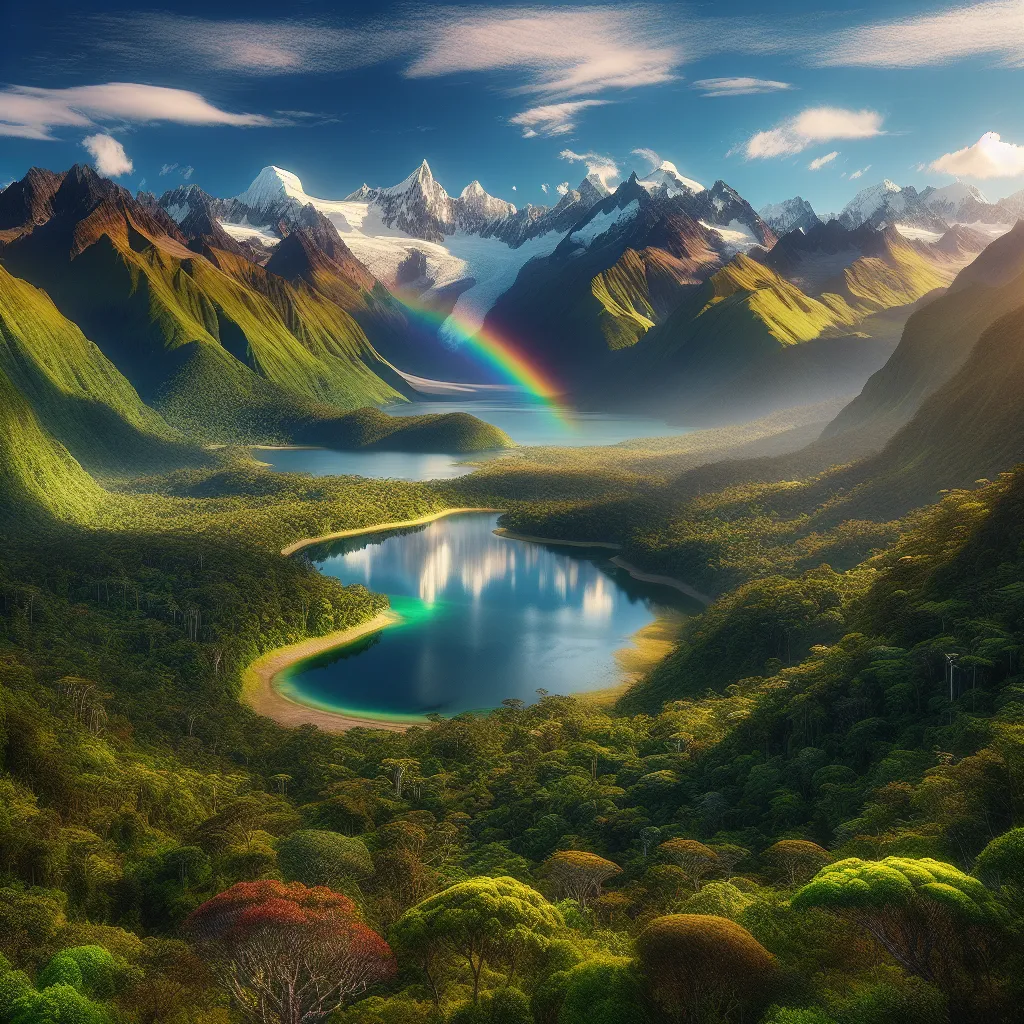As an experienced IELTS Speaking examiner, I’ve encountered numerous responses to the topic “Describe a place where you experienced natural beauty.” This subject is not only captivating but also provides ample opportunity for candidates to showcase their language skills. In this comprehensive guide, we’ll explore how to excel in this IELTS Speaking task, focusing on vocabulary, structure, and delivery techniques that can elevate your score.
Nội dung bài viết
- Understanding the Task: Describing Natural Beauty in IELTS Speaking
- Part 1: Introduction and Interview
- Sample Question: Do you enjoy visiting natural places?
- Part 2: Long Turn (Cue Card)
- Sample Answer (Band 8-9)
- Examiner’s Follow-up Questions
- Part 3: Two-way Discussion
- Question 1: How do you think exposure to natural beauty affects people’s well-being?
- Question 2: Do you think the concept of natural beauty varies across cultures?
- Key Vocabulary and Phrases for High Scores
- Examiner’s Advice for High Scores in IELTS Speaking
Understanding the Task: Describing Natural Beauty in IELTS Speaking
The topic of natural beauty is a perennial favorite in IELTS Speaking tests, appearing frequently in Part 2 (Long Turn) and occasionally inspiring follow-up questions in Part 3. Its popularity stems from its universality and the rich descriptive language it allows candidates to demonstrate.
 Breathtaking natural landscape
Breathtaking natural landscape
Part 1: Introduction and Interview
While the main task of describing a place of natural beauty typically appears in Part 2, the examiner may warm up with related questions in Part 1. Here are some potential questions and suggested responses:
Sample Question: Do you enjoy visiting natural places?
Band 6-7 Response:
“Yes, I do. I find natural places very relaxing and beautiful. I try to visit parks or beaches whenever I have free time.”
Band 8-9 Response:
“Absolutely! I’m utterly captivated by the raw beauty of nature. There’s something profoundly rejuvenating about immersing oneself in unspoiled landscapes, whether it’s a verdant forest or a pristine coastline. I make it a point to seek out such places regularly to recharge my batteries and gain a fresh perspective on life.”
Part 2: Long Turn (Cue Card)
Here’s a sample cue card for this topic:
Describe a place where you experienced natural beauty
You should say:
- Where this place is
- When you went there
- What you saw there
- And explain why you think this place is beautiful
Remember, you have one minute to prepare and should speak for 1-2 minutes.
Sample Answer (Band 8-9)
“I’d like to talk about an awe-inspiring experience I had when visiting the majestic Banff National Park in Alberta, Canada. I had the opportunity to explore this breathtaking wilderness last summer during a backpacking trip across North America.
The park is renowned for its stunning Rocky Mountain landscapes, and it certainly lived up to its reputation. As soon as I entered the park, I was struck by the sheer grandeur of the snow-capped peaks that seemed to pierce the sky. The pristine turquoise lakes, particularly Lake Louise and Moraine Lake, were so vivid and clear that they appeared almost surreal.
One of the most memorable sights was the abundance of wildlife. I was fortunate enough to spot a majestic elk grazing in a lush meadow, and even caught a glimpse of a grizzly bear in the distance – from a safe vantage point, of course!
The natural beauty of Banff is truly unparalleled in my experience. What makes it so special is the harmonious blend of diverse elements – the rugged mountains, the serene lakes, the verdant forests, and the rich wildlife. It’s a place where you can witness the raw power of nature in the glaciers and waterfalls, while also experiencing moments of profound tranquility in the quiet forests.
Moreover, the way the landscape transforms with the changing light throughout the day is mesmerizing. From the soft, golden glow of sunrise over the mountains to the spectacular array of colors painting the sky at sunset, every moment offered a new perspective on the park’s beauty.
In essence, Banff National Park embodies the very definition of natural beauty for me. It’s a place that not only captivates the eye but also stirs the soul, leaving a lasting impression that continues to inspire and humble me long after my visit.”
Examiner’s Follow-up Questions
- How did your visit to this place impact your views on nature conservation?
- Do you think natural beauty can be preserved while also developing tourism in an area?
Sample Answer (Band 8-9):
“My visit to Banff National Park profoundly influenced my perspective on nature conservation. Witnessing such unspoiled beauty firsthand really drove home the importance of preserving these natural wonders for future generations. It made me realize that we have a collective responsibility to protect these ecosystems, not just for their aesthetic value, but for their crucial role in maintaining biodiversity and combating climate change.
Regarding the balance between preservation and tourism development, I believe it’s a delicate but achievable equilibrium. Sustainable tourism practices can actually contribute to conservation efforts by raising awareness and providing funding. However, it’s imperative that any development is done with utmost care and respect for the environment. This might involve implementing strict visitor quotas, using eco-friendly infrastructure, and educating tourists about responsible behavior in natural settings. Places like Banff have shown that it’s possible to allow people to experience natural beauty while minimizing human impact. The key is in prioritizing long-term sustainability over short-term gains.”
Part 3: Two-way Discussion
In this section, the examiner will ask more abstract questions related to the topic. Here are some potential questions and suggested responses:
Question 1: How do you think exposure to natural beauty affects people’s well-being?
Band 6-7 Response:
“I think being in nature is good for people’s health. It helps reduce stress and makes people feel happier. Many people feel more relaxed after spending time outdoors in beautiful places.”
Band 8-9 Response:
“I firmly believe that exposure to natural beauty has a profound and multifaceted impact on human well-being. On a psychological level, it can significantly alleviate stress and boost mood, acting as a natural antidote to the pressures of modern urban life. Studies have shown that even brief encounters with nature can lower cortisol levels and enhance cognitive function.
Moreover, experiencing natural beauty often instills a sense of awe that can put our personal concerns into perspective, fostering a more balanced outlook on life. It can also spark creativity and inspire problem-solving, as the patterns and processes in nature often serve as models for innovation.
Physically, outdoor activities in beautiful natural settings encourage exercise and exposure to fresh air and sunlight, which are crucial for overall health. The sensory richness of natural environments – the sounds, smells, and textures – provides a form of cognitive restoration that’s increasingly recognized as vital in our digitally saturated world.
In essence, I’d argue that regular exposure to natural beauty is not just beneficial, but essential for holistic well-being in our increasingly urbanized societies.”
Question 2: Do you think the concept of natural beauty varies across cultures?
Band 6-7 Response:
“Yes, I think different cultures might have different ideas about what’s beautiful in nature. Some might prefer mountains, while others might like beaches more. It probably depends on what people are used to seeing in their own countries.”
Band 8-9 Response:
“The concept of natural beauty is undoubtedly influenced by cultural perspectives, though I believe there are also some universal aspects. Different cultures may prioritize certain landscapes or natural features based on their historical, religious, or aesthetic traditions. For instance, in Japanese culture, there’s a deep appreciation for the subtle beauty of rock gardens and carefully pruned bonsai trees, which might not be immediately recognized as ‘natural beauty’ in Western cultures that often equate natural beauty with wilderness.
That said, there are some aspects of natural beauty that seem to transcend cultural boundaries. The awe inspired by vast, open spaces like mountains or oceans, the tranquility of forest environments, and the vibrancy of colorful phenomena like rainbows or autumn foliage tend to be universally appreciated.
Interestingly, globalization and increased travel have led to a cross-pollination of aesthetic values regarding natural beauty. We’re seeing a growing convergence in appreciation for diverse natural landscapes, perhaps driven by shared concerns about environmental conservation.
However, it’s crucial to recognize and respect these cultural differences in perceiving natural beauty, as they often reflect deeper cultural values and relationships with the environment. Understanding these variations can enrich our own appreciation of the natural world and foster cross-cultural dialogue on environmental issues.”
Key Vocabulary and Phrases for High Scores
To elevate your IELTS Speaking score when describing natural beauty, incorporate these sophisticated words and phrases:
-
Awe-inspiring /ɔː ɪnˈspaɪərɪŋ/ (adjective): Causing feelings of awe or admiration.
Example: “The Grand Canyon is truly an awe-inspiring sight.” -
Breathtaking /ˈbreθteɪkɪŋ/ (adjective): Astonishing or exciting; taking one’s breath away.
Example: “The view from the mountain peak was absolutely breathtaking.” -
Pristine /ˈprɪstiːn/ (adjective): In its original condition; unspoiled.
Example: “We enjoyed swimming in the pristine waters of the secluded bay.” -
Majestic /məˈdʒestɪk/ (adjective): Having beauty, grandeur, or dignity.
Example: “The majestic sequoia trees towered over us in the forest.” -
Serene /səˈriːn/ (adjective): Calm, peaceful, and untroubled.
Example: “The serene atmosphere of the lake at dawn was incredibly relaxing.” -
Captivating /ˈkæptɪveɪtɪŋ/ (adjective): Capable of attracting and holding interest; charming.
Example: “The Northern Lights put on a captivating display in the night sky.” -
To be in awe of (phrase): To feel great admiration or wonder for something.
Example: “I was completely in awe of the vast expanse of the Sahara Desert.” -
Unspoiled /ˌʌnˈspɔɪld/ (adjective): Not having been changed in an undesirable way; pristine.
Example: “We discovered an unspoiled beach, far from any tourist developments.” -
Picturesque /ˌpɪktʃəˈresk/ (adjective): Visually attractive, especially in a quaint or charming way.
Example: “The picturesque village nestled in the valley was like something from a postcard.” -
To take one’s breath away (idiom): To astonish or overwhelm with beauty or grandeur.
Example: “The first sight of the Taj Mahal at sunrise simply took my breath away.”
Examiner’s Advice for High Scores in IELTS Speaking
To achieve a high score in the IELTS Speaking test, particularly when describing natural beauty:
-
Use varied vocabulary: Incorporate a range of descriptive adjectives and phrases to vividly portray the scene.
-
Provide specific details: Don’t just say a place is beautiful; explain why with concrete examples.
-
Express personal feelings: Share how the natural beauty affected you emotionally or psychologically.
-
Use advanced grammatical structures: Employ complex sentences, conditionals, and a mix of tenses appropriately.
-
Maintain fluency: Practice speaking at length about natural scenes to improve your ability to talk without hesitation.
-
Show critical thinking: In Part 3, demonstrate your ability to analyze and discuss abstract concepts related to natural beauty.
-
Be authentic: While using sophisticated language is important, ensure your responses sound natural and genuine.
Remember, consistent practice and exposure to a variety of natural settings and descriptions will significantly enhance your ability to excel in this topic. Good luck with your IELTS preparation!
For more tips on IELTS Speaking, you might find these resources helpful:


